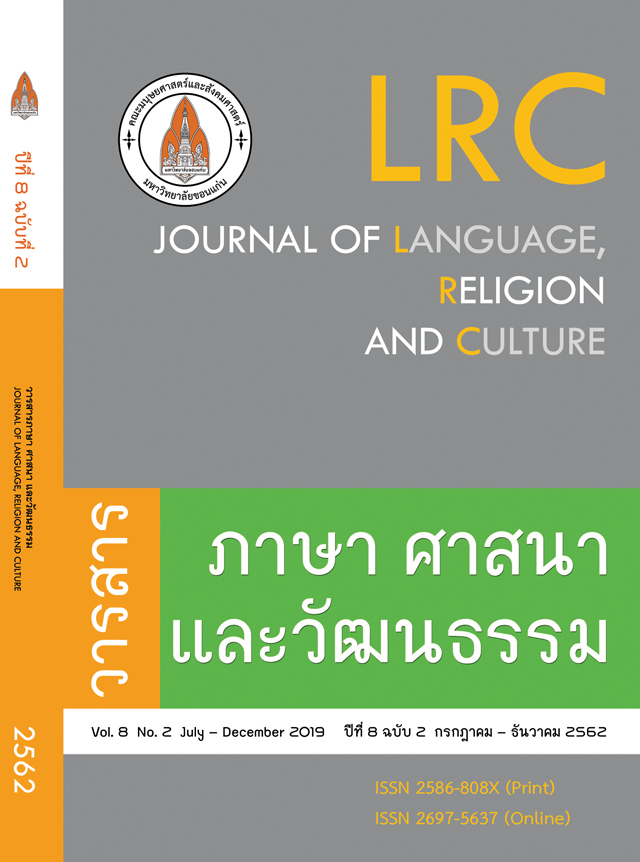สำนวนไทยและสำนวนจีนที่มีคำว่า “งู” ; Thai and Chinese Proverb with the Word “Snake”
Keywords:
งู, สำนวนไทย, สำนวนจีน, ความเข้าใจ, snake, Thai proverb, Chinese proverb, comprehensionAbstract
บทคัดย่อ
งานวิจัยเรื่องนี้มีวัตถุประสงค์เพื่อ 1) ศึกษาประเภทของสำนวนไทยและสำนวนจีนที่มีคำว่า “งู” 2) ศึกษาภาพสะท้อนของสำนวนที่มีคำว่า “งู” ของทั้ง 2 ภาษา 3) ศึกษาความเข้าใจในการใช้สำนวนไทยมีคำว่า “งู” ของนักศึกษา กลุ่มตัวอย่างคือ นักศึกษาปริญญาตรี สาขาวิชาภาษาอังกฤษเพื่อการสื่อสารสากล จำนวน 121 คน แยกตามชั้นปีการศึกษา เครื่องมือในการวิจัย คือ แบบทดสอบวัดความเข้าใจการใช้สำนวนไทยมีคำว่า “งู” สถิติที่ใช้ในการวิจัยคือ การหาค่าเฉลี่ย การหาค่าส่วนเบี่ยงเบนมาตรฐาน และการแจกแจงความถี่แบบกลุ่ม
ผลการวิจัย 1) สำนวนไทยและสำนวนจีนที่มีคำว่า “งู” สามารถแบ่งได้ 3 ประเภท คือ ประเภทสำนวนไทยที่มีคำว่า “งู” กับสำนวนจีนที่มีคำว่า “งู” เหมือนกัน ประเภทสำนวนไทยไม่มีคำว่า “งู” แต่สำนวนจีนมีคำว่า “งู” และประเภทสำนวนไทยมีความหมายตรงกันกับสำนวนจีนแต่สำนวนไทยใช้คำอื่น 2) สำนวนที่มีคำว่า “งู” ของทั้ง 2 ภาษา มีจำนวน 5 ลักษณะการสะท้อน คือ ทางธรรมชาติ ทางพฤติกรรมและความรู้สึกนึกคิดของมนุษย์และสัตว์ ทางวิถีชีวิตความเป็นอยู่ ที่อยู่อาศัย ทางความเชื่อ ศาสนา และทางเครื่องดนตรี การละเล่น 3) ความเข้าใจการใช้สำนวนไทยที่มีคำว่า “งู” ของนักศึกษา พบว่า ชั้นปีที่ 1 และชั้นปีที่ 4 มีค่าระดับความเข้าใจมาก ส่วนชั้นปีที่ 2 และชั้นปีที่ 3 มีค่าระดับความเข้าใจปานกลาง และคะแนนเฉลี่ยรวมของนักศึกษาทุกชั้นปีมีค่าระดับความเข้าใจปานกลาง
Abstract
The objectives of this research were: 1) to study the types of Thai and Chinese proverb with the word “snake”, 2) to study the reflection of the proverb with the word “snake” of Thai and Chinese languages, and 3) to study the understanding of using Thai idioms with the word “snake” of students. The sample group was undergraduate students majoring in English for international communication. The 121 students were classified by academic year, and they enrolled in the second semester of academic year 2018. Research tool was the comprehension test of Thai proverb with the word “snake”. The statistics used for data analysis were mean, standard deviation, and frequency distribution table.
The result of research revealed as follows: 1) The types of Thai and Chinese proverb with the word “snake” can be divided into three types: the Thai idioms with the word “snake” and Chinese idioms with the word “snake” that have the same meaning; the Thai proverb without the word “snake”, but Chinese proverb with the word “snake”; and the Thai idioms are synonymous with Chinese proverb, but Thai proverb uses other words. 2) The reflection of proverb with the word “snake” of two languages was found that there were five characteristics of reflection: nature, human and animal behavior including their feelings, way of life including residence, belief with religion, and musical instruments including play. 3) The understanding of using Thai idioms with the word “snake” of students was found that first-year students and fourth-year students had a high level of understanding. Meanwhile, second-year students and third-year students had a moderate level of understanding. The median of all students had a moderate level of understanding.
References
กฤชกร เพชรนอก. (2558). สุภาษิต คำพังเพย และสำนวนไทย. พิมพ์ครั้งที่ 8. กรุงเทพฯ : สกายบุ๊กส์.
กัญญรัตน์ เวชชศาสตร์. (2559). มโนทัศน์เรื่องนาคของชนชาติไท, Veridian E - Journal Silapakorn University. 9(1) : 1099 - 1116.
เกสรา ลี้เจริญ. (2562). ศัพท์วัยรุ่น 2018. [ออนไลน์]. ได้จาก https://seventeenthailand.com/2016-2018 [สืบค้นเมื่อ วันที่ 6 สิงหาคม 2562].
จิรวัฒน์ เพชรรัตน์. (2560). ความสามารถในการใช้ภาษาไทยของนักศึกษา ระดับปริญญาตรี มหาวิทยาลัยเทคโนโลยีราชมงคลธัญบุรี. วารสารมนุษยศาสตร์ มหาวิทยาลัยนเรศวร, 14(3) : 49 - 62.
ชูศรี วงศ์รัตนะ. (2560). เทคนิคการใช้สถิติเพื่อการวิจัย. พิมพ์ครั้งที่ 13. กรุงเทพฯ: อมรการพิมพ์.
ดวงเดือน สุวัตถี. (2524). ภาษาศาสตร์กับการเรียนการสอนภาษาต่างประเทศ. กรุงเทพฯ : จุฬาลงกรณ์มหาวิทยาลัย.
ทิศนา แขมมณี. (2545). กระบวนการเรียนรู้ : ความหมาย แนวทางการพัฒนาและปัญหาข้องใจ. กรุงเทพฯ : เอกสารเผยแพร่โครงการ วพร..
บุญชม ศรีสะอาด. (2542). วิธีการสถิติสำหรับการวิจัย. พิมพ์ครั้งที่ 2. กรุงเทพฯ: สุวีริยาสาสน์.
ประเพศ ไกรจันทร์. (2558). ครบเครื่องเรื่องสำนวนอังกฤษ (Complete English Idioms). กรุงเทพฯ : พี.เอส.เพรส..
ฝ่ายวิชาการไอคิวพลัส. (2558). พจนานุกรมไทยใหม่ล่าสุด. ฉะเชิงเทรา : พีเอ็นเอ็น มีเดียกรุ๊ป.
พิชิต ฤทธิ์จรูญ. (2545). หลักการวัดและประเมินผลการศึกษา. พิมพ์ครั้งที่ 2. กรุงเทพฯ : เฮ้าส์ ออฟ เคอร์มีสท์.
วรวรรณ คงมานุสรณ์. (2545). รู้ถ้วนสำนวนไทย. พิมพ์ครั้งที่ 5. กรุงเทพฯ : อักษรเจริญทัศน์.
วิจิตรมาตรา, ขุน (สง่า กาญจนาคพันธุ์). (2543). สำนวนไทย. กรุงเทพฯ : โรงเรียนภาษาและวัฒนธรรมสมาคมส่งเสริมเทคโนโลยี (ไทย - ญี่ปุ่น).
วิเชียร เกตุสิงห์. (2538). การวิจัยเชิงปฏิบัติ. กรุงเทพฯ : จุฬาลงกรณ์มหาวิทยาลัย.
สิรินธร สินจินดาวงศ์. (2547). วิธีการวิเคราะห์ข้อสอบ. วารสารวิจัยศรีปทุมปริทัศน์, 4(1) : 21 - 33.
สิริวรรณพิชา ธนจิราวัฒน์. (2559). การศึกษาเปรียบเทียบภาพสะท้อนทางวัฒนธรรมผ่านสำนวนไทย จีน และอังกฤษ, วารสารบัณฑิตศึกษา มนุษยศาสตร์และสังคมศาสตร์ มหาวิทยาลัยขอนแก่น, 5(1) : 59 - 82.
สุชาดา กุลบุตร. (2555). การศึกษาวิเคราะห์สุภาษิตจีนที่มีตัว 牛. วิทยานิพนธ์ศิลปศาสตรบัณฑิต, มหาวิทยาลัยอุบลราชธานี.
สุรศักดิ์ แย้มอุ่น. (2552). วากยสัมพันธ์ในภาษาไทยและภาษาสันสกฤต : การศึกษาเปรียบเทียบ. วิทยานิพนธ์ศิลปศาสตร มหาบัณฑิต, มหาวิทยาลัยศิลปากร.
หนีเจิงฟาง. (2008). 中西蛇文化审美. งานวิจัย, วิทยาลัยเทคโนโลยีและวิทยาศาสตร์หูน๋าน.
หลี่ช๋วนเจียง. (2013). 试析《搜神记》中的文化. วิทยานิพนธ์มหาบัณฑิต, มหาวิทยาลัยครูหน๋านจิง.
Benjamin S. Bloom, J. Thomas Hastings and George F. madaus. (1956). Handbook on Formation and Summative of Student Learning. New York : Mc graw Hill.
Huang Haiyuan, I Dewa Putu Wijana and Tatang Hariri. (2016). A Comparision of the Origin of Idioms in Mandarin and Indonesian. Humaniora, V28 n2 : 121 - 130.
Lakeoff,G. and Johnson,M.. (2003). Metaphor we live by. Chicaco : University of Chicaco.
Matlin. M. W. (1995). Psychology. 2nded. : Holt Rinehart and Winston, Inc.
Pearson,P.D. and Johnson. (1978). Teaching reading Comprehension. New York : Holt, Rinehart and Winston.
Shi Wenjuan and Jiang Yuhong. (2015). Comparision and Contrast Between English and Chinese Idioms From Cultural Connotation Perspective. CSCanada Studies in Literature and language, V10 n1, 102 - 113.
Yamane Taro. (1967). Statistics, An Introductory Analysis. 2nd ed. New York : Harper and Row.
成语大词典编委会. (2012). 成语大词典. 第二版. 北京 : 商务国际有限公司.
尔雅辞书编委会. (2015). 汉语成语词典. 吉林 : 吉林出版集团
范氏缘红. (2018). 汉越成语中的数词对比研究. 硕士学位, 广西师范大学.
开心辞书研究中心. (2015). 小学生多功能成语词典. 甘肃 : 甘肃教育.
夏征农. (1989). 辞海 (缩印本). 上海 : 上海辞书.







